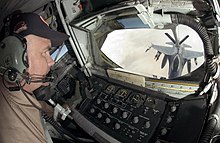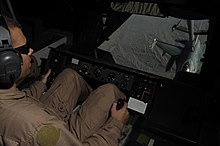In the U.S. Air Force (USAF), a boom operator is an aircrew member aboard tanker aircraft who is responsible for safely and effectively transferring aviation fuel from one military aircraft to another during flight (known as aerial refueling, air refueling, in-flight refueling, air-to-air refueling, and tanking). The name boom operator implies that one "operates a boom" (the flying boom), which is a long, extendable metal arm attached to the rear underside of the tanker that the boom operator connects to the fuel receptacle of a receiving aircraft (the receiver). The boom operator also controls the refueling drogue, a basket attached to a flexible hose that trails the tanker, when using the probe-and-drogue system.[1][9][10][11] The USAF officially designates the boom operator career field as "In-Flight Refueling" with a specialty code of 1A0X1. However, this designation is usually reserved for administrative paperwork such as enlistment contracts and performance reports, as boom operators themselves are rarely referred to as in-flight refueling specialists within the USAF. The title "Boom Operator" is most commonly used, in reference to the aircrew position they occupy on the airplane, as noted in USAF regulations and aircraft flight manuals.[3][12][13] Fellow crew members affectionately address them as "boom" or "boomer"[4][7] (though the use of the term "boom" in this article refers to the flying boom, not the boom operator).
| USAF Boom Operator | |
|---|---|
 | |
| Active | September 16, 1948[1][2] – present (76 years, 2 months) |
| Country | |
| Branch | |
| Type | In-flight refueling specialist[3] |
| Role | Aerial refueling (U.S. & allies) Airlift (cargo & personnel) Special operations Nuclear operations[1][3][4][5] |
| Size | 765 (90% male, 10% female)[6] |
| Garrison/HQ | List of Air Refueling Squadrons |
| Nickname(s) | "Boom", "Boomer"[4][7] |
| Motto(s) | "Nobody Kicks ASS Without Tanker Gas!" (NKAWTG)[8] |
| Engagements | |


The boom operator crew position was created in 1948 when Boeing developed the flying boom at the request of the USAF. Prior to this, when the only practical means of transferring fuel was through a hose, other crew members fulfilled the duty of operating the air refueling equipment, such as the hose reel operator in the DH-4B and C-1 and the line operator in the B-24D and KB-29M using the grappled-line looped hose system.[1][9] In the modern U.S. military, the boom operator crew position only exists in USAF tankers equipped with a flying boom, such as the KC-135, KC-10, and the newly developed KC-46. For tanker aircraft not equipped with a flying boom, such as the KC-130, HC-130, and F/A-18E/F, the specific crew member(s) responsible for operating the air refueling equipment and supervising refueling operations varies by aircraft. Boom-equipped tankers have been obtained by several foreign countries as a result of USAF tanker procurement programs and U.S. foreign military sales. An estimated 63 boom-equipped tankers (KC-135,[14][15][16] KC-10,[17] A330 MRTT,[18][19] KC-767,[20][21][22][23] and KC-33[24]) are operated by 14 foreign countries; in comparison, the USAF operates 457 KC-135 and KC-10 tankers.[10][11][25][26]
Requirements
editA boom operator must have a high school diploma or GED with 15 college credits. They must have normal depth perception, cannot be shorter than 64 inches (160 cm) or taller than 77 inches (200 cm), must complete a Single Scope Background Investigation, and complete seven and a half weeks of basic military training, and Airmen's week, and must be between the age of 17 and 39.[13]
Training
editAll boom operators first receive a month of training in flying tankers at Joint Base San Antonio, Texas. After this they spend three weeks in survival training. The boom operators of Boeing KC-135 Stratotankers are trained at Altus Air Force Base for four months.[27]
Equipment
editBoom operators are used in McDonnell Douglas KC-10 Extenders and Boeing KC-135 Stratotankers.[4] The Boeing KC-46 Pegasus is currently being deployed for use in refueling.[28] The KC-10 station is in a rear-facing seat while the KC-135 is in a prone position. The KC-46 seats two operators in the front of the aircraft with 3D viewing screens fed by cameras. The future training program for the KC-46 for a boom operator is to be 59 days long, and the training time for a pilot is to be 82 days long.[29]
Aircraft
editThis section needs to be updated. The reason given is: KC-46 is now in service. (May 2022) |
This section refers to operational tankers crewed by USAF boom operators since the development of the flying boom in 1948. For a complete list of U.S. military tankers, see List of United States military aerial refueling aircraft.
In Service
edit| Image | Tanker | Operational | Attributes |
|---|---|---|---|
| Boeing KC-135 Stratotanker | 1957–present |
| |
| McDonnell Douglas KC-10 Extender | 1981–present |
| |
| Boeing KC-46 Pegasus | 2019 - present |
|
Under Development
editRetired
edit| Image | Tanker | Operational | Attributes |
|---|---|---|---|
| Boeing KB-29 Superfortress | 1948–1957 |
| |
| Boeing KB-50 Superfortress | 1956–1965 |
| |
| Boeing KC-97 Stratofreighter | 1951–1978 |
Gallery
edit-
-
A boom operator in a USAF KC-135 conducts a preflight inspection in the boom pod prior to a mission in the Middle East.
-
The challenge coin for a boom operator.
See also
edit- Aircrew (Flight crew)
References
edit- ^ a b c d e f g h i Smith, Richard K. (1998). Seventy-Five Years of Inflight Refueling: Highlights, 1923-1998. Washington, D.C.: Air Force History and Museums Program. ISBN 0160497795.
- ^ Gentry, SMSgt M.A. "The History of Air Refueling" (PDF). Air University. Air Force Enlisted Heritage Research Institute. Retrieved 21 April 2018.
- ^ a b c Department of The Air Force. "AFSC 1A0X1 In-Flight Refueling Career Field Education And Training Plan (CFETP)" (PDF). e-publishing.af.mil. Retrieved 7 January 2017.
- ^ a b c d Rogoway, Tyler (20 May 2014). "Confessions Of A USAF KC-135 'Flying Gas Station' Boom Operator". Foxtrot Alpha. Retrieved 5 January 2017.
- ^ Kristensen, Hans M. (15 March 2006), Global Strike: A Chronology of the Pentagon's New Offensive Strike Plan (PDF), Federation of American Scientists
- ^ "1A0X1 – IN-FLIGHT REFUELING". foreverwingman.com. Retrieved 15 April 2018.
- ^ a b Richardson, Airman 1st Class Mackenzie. "KC-135 Stratotanker tour [Image 3 of 5]". Defense Visual Information Distribution Service (DVIDS). USAF. Retrieved 15 April 2018.
{{cite web}}: CS1 maint: numeric names: authors list (link) - ^ "N.K.A.W.T.G – NOBODY KICKS ASS WITHOUT TANKER GAS". Fly Mag. Scandinavian Aviation Magazine. Retrieved 15 April 2018.
- ^ a b May, Mike. "Gas Stations In The Sky". inventionandtech.com. Invention & Technology. Retrieved 22 January 2017.
- ^ a b Piesing, Mark. "The Aerial Tankers That Helped Shrink the Globe". BBC. Retrieved 22 January 2017.
- ^ a b Day, Dwayne A. "Aerial Refueling". centennialofflight.net. U.S. Centennial of Flight Commission. Retrieved 22 January 2017.
- ^ Powers, Rod. "1A0X1 - In-Flight Refueling - Air Force Job Description". The Balance. Retrieved 7 January 2017.
- ^ a b U.S. Air Force. "U.S. Air Force - Career Detail - In-flight Refueling". www.airforce.com. Retrieved 5 January 2017.
- ^ "Llegó el 1er KC-135E para la FACh - ModoCharlie". modocharlie.com. 16 February 2010. Archived from the original on 24 March 2017. Retrieved 26 April 2018.
- ^ Boeing: Boeing Delivers First KC-135R to Singapore Air Force Archived 14 October 2007 at the Wayback Machine
- ^ "Singapore to join coalition against Islamic State". AFP. Archived from the original on 4 November 2014. Retrieved 4 November 2014.
- ^ "Evaluatie project KDC-10". Ministerie van Defensie (in Dutch). 1 July 1999. Retrieved 5 January 2014.
- ^ "Airbus D&S Orders & deliveries pdf" (PDF). Airbus S.A.S. 30 November 2016. Archived from the original (PDF) on 11 August 2018. Retrieved 5 January 2018.
- ^ "MMF Background Paper - Flashback: From acknowledging Europe's Air-to-Air Refuelling gap to today's MFF signing" (PDF). Airbus Defence & Space. July 2016. Archived from the original (PDF) on 17 July 2017. Retrieved 17 July 2017.
- ^ Sanchez, Felix and Marcello Bruni. "Boeing KC-767 Tankers for Italian Air Force Formally Enter into Service." Boeing, 17 May 2011.
- ^ Boeing (January 5, 2012), Boeing Reports Fourth-Quarter Deliveries, Boeing
- ^ "Boeing Delivers 4th KC-767 Tanker to Japan Ministry of Defense". Boeing, 12 January 2010.
- ^ "Brazil to add third converted 767 tanker". Flight International. 27 May 2014. Retrieved 26 January 2015.
- ^ "KC-33A: Closing the Aerial Refuelling and Strategic Air Mobility Gaps (PDF)." Air Power Australia Analysis APA-2005-02, April 16, 2005. Retrieved: December 17, 2007.
- ^ a b "2017 USAF Almanac, Fact and Figures" (PDF). Air Force Magazine. May 2017. Archived from the original (PDF) on 2018-04-26. Retrieved 2018-05-03.
- ^ a b "KC-10 Extender". U.S. Air Force. USAF. Retrieved 16 April 2018.
- ^ "What it takes to be a boom operator". U.S. Air Force. Retrieved 5 January 2017.
- ^ "412th Test Wing". www.aerotechnews.com. Retrieved 5 January 2017.
- ^ "KC-46 Flight Simulators To Enable Pilots, Boom Operators To Train Together". Defense News. Retrieved 5 January 2017.
- ^ "KC-46 TANKER MODERNIZATION" (PDF). U.S. Government Accountability Office. U.S. Government Accountability Office. Retrieved 6 May 2018.
- ^ "Boeing Receives US Air Force Contract to Build Next-Generation Refueling Tanker". Boeing MediaRoom. Boeing. Retrieved 16 April 2018.